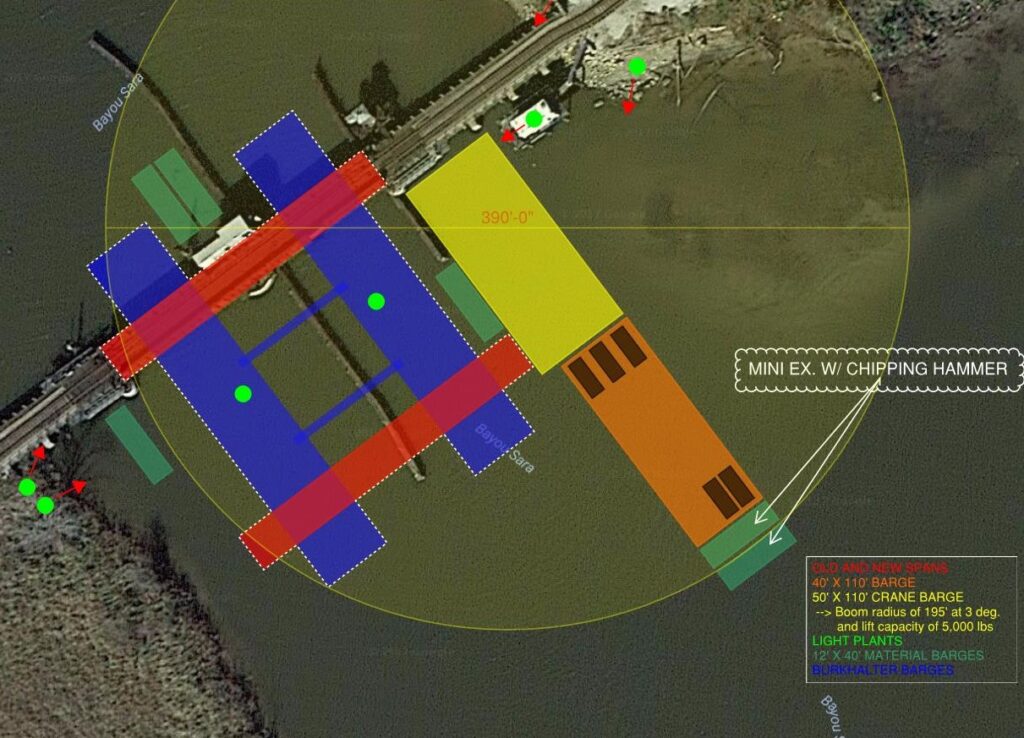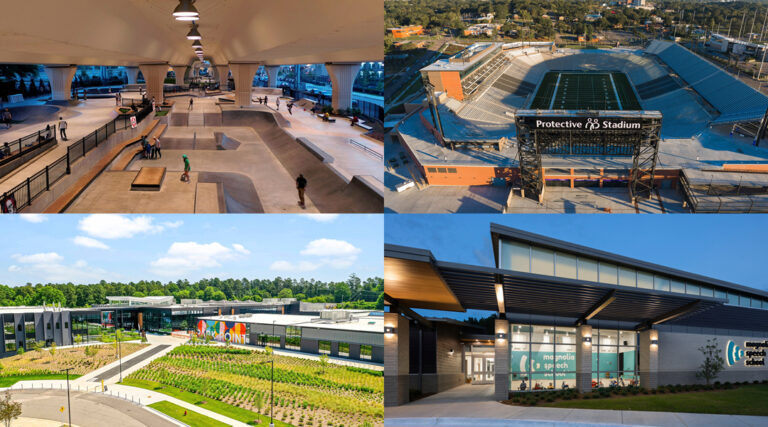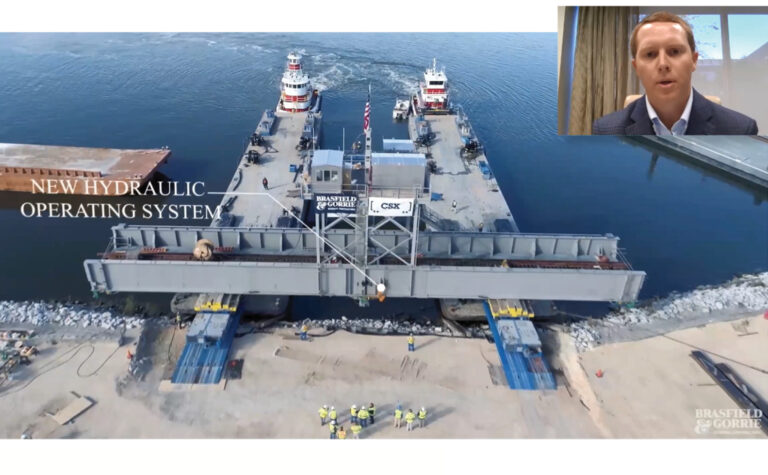- Infrastructure
An Accelerated Bridge Construction Success Story: CSX Bayou Sara Swing Span Replacement
March 5, 2019
As bridges become the primary focus of infrastructure improvement, innovative construction techniques have been developed to provide cost-effective and efficient methods for rehabilitation or replacement. One such technique is accelerated bridge construction. This technique typically utilizes offsite assembly and transportation of the assembled components to the project site for installation. Accelerated bridge construction provides clear benefits, such as faster installation, decreased impact to surrounding areas, and increased safety. It is also extremely challenging, requiring extensive collaboration and detailed planning from the project team, including the client, engineer, and contractor.
One of Brasfield & Gorrie’s recent projects, the CSX Bayou Sara Swing Span Replacement in Mobile, Alabama, is a great example of a successfully executed ABC project. The project involved replacing a 100-year-old railroad swing span bridge to minimize maintenance and allow for remote operation. Located in a remote, difficult-to-access area, the project involved logistical challenges associated with working on the water. In addition, it was critical that the rail service interruption be limited to only 14 hours during the construction phase.
Our project team considered many factors and construction techniques when planning for this project. Innovative strategies in four key areas helped us overcome the challenges to complete this project successfully.
Collaboration
Given the challenges, collaboration among our project team was critical to the success of this project. Prior to construction, we were asked to significantly reduce the rail service interruption window to remove and replace the swing span from 48 to 14 hours. Our project team held weekly conference calls to develop a structural steel embed concept (grillage) that would distribute the bridge and train loads directly to the existing center pier foundation. The grillage removed the requirement to cast the top portion of the center pier foundation back in concrete prior to running trains on the bridge, which significantly helped reduce the overall outage duration. The collaboration between our project team and our steel fabricator allowed us to conceptualize, design, and procure the grillage in less than two months.

Scheduling and Logistics
Our project team developed a comprehensive float-in plan noting the pre-outage, outage, and post-outage activities to promote understanding about the overall scheme to remove and replace the existing swing span. We submitted this plan to the client and engineer for feedback and discussion during our weekly calls. The plan helped define the responsibilities of our project team stakeholders leading up to and during the float-in and included narratives of key activities, site logistics, staging diagrams, activity scripts, and construction engineering documents relative to various aspects of the work.
Used as a form of micro-scheduling, the activity scripts were a key component in preparing for and executing the work. Each key activity was broken down into several tasks. The script included the field crew responsible for performing the work, materials and equipment required, and a target activity duration to the nearest 15 minutes. The use of micro-scheduling with the activity scripts helped identify the critical path and possible contingency plans.
Quality Control
Two quality control measures our project team focused on were horizontal and vertical bridge alignment and machinery alignment. Since the swing span is a moveable structure, the machinery that drives the bridge must be installed to the nearest thousandth to ensure the components operate efficiently and last for the estimated lifecycle of the bridge. We took several measurements prior to the float-in to ensure the alignment of the bridge and machinery were not sacrificed for schedule.
At the rest piers, we located and cored the new wedge seat anchor bolt holes prior to float-in. We also chipped down and smoothed the rest pier concrete at each wedge seat location and installed steel shim pack bases. The shim pack bases provided a level surface for installing supplemental shims up to the bottom of the wedge seat elevation. To accelerate horizontal bridge alignment during the float-in, we installed bridge stops at the back corners that used a threaded extension plate to align the horizontal position prior to float-in. We installed four bridge stops but only used three, leaving room to float the bridge in and position it into one corner.
An added benefit of the grillage was that the mechanical components could be bolted to it prior to the float-in. We used a third-party measurement company to check the machinery rack flatness and horizontal alignment relative to the center of the bridge and pinion drive motors. Once the rack and machinery were aligned, we locked the jacking frame used to support the grillage into place, along with blocking and several come-along and ratchet straps, to limit the grillage movement during the span transport and float-in.
Productivity
The above-noted strategies all directly contributed to our team’s productivity during the swing span replacement. Through extensive collaboration, we developed an effective solution to help significantly reduce the overall rail service interruption. Compiling the float-in-plan and using detailed activity scripts allowed us to determine the best possible strategies and solutions to work efficiently. We completed much of the work required to replace the bridge prior to the float-in, including wire sawing the top portion of the existing center pier while trains were still using the existing swing span. Using bridge stops to align the new span expedited lowering the span into place so the anchor bolts could be installed, grouted, and cured prior to releasing the first train.
A special thanks is extended to our entire project team for contributing to the success of this project, including our Brasfield & Gorrie team members, our engineering partners from HDR, and our client, CSX Transportation. View the video below to see the float-in in action.
About the author: As a project manager in Brasfield & Gorrie’s Infrastructure division, Kevin Kane is the primary manager of the day-to-day aspects of the project that will ensure its success. He works with the project team to plan, manage, and execute the project, specifically focusing on the critical path and the details that affect the project’s cost, schedule, quality, and safety. With a father who was a superintendent for more than 35 years, Kane developed a passion for the construction industry at an early age. After earning his bachelor’s and master’s degrees in civil engineering from Auburn University, he was hired by Brasfield & Gorrie and has successfully managed a variety of infrastructure projects and gained the trust of key clients.
Related


